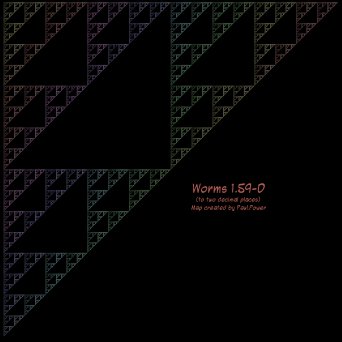Latest announcement: Due to recent abuse of our services, anonymous map uploading has temporarily been disabled. Only registered users will be able to submit new maps.
Worms 1.59-D by PaulPower

View in Full Size | Play now
Type: Other
Size: 2096 x 2096, 137KB
Tags: fractal, sierpinski gasket, fractional dimensions
Ratings:
Following on from #10925 we have Worms 1.59-D, fought on a Sierpinski Gasket/Sierpinski Triangle rather than a Sierpinski Carpet. Because this map is rather more sparse (and correspondingly of lower dimension) than its carpet cousin, it should be correspondingly easier to tunnel through to your opponents (especially at the corners of the triangles) and that much more playable.
Since people asked me to explain why these fractal maps are anything other than two-dimensional, I'll put an explanation in here.
There are many ways of describing the number of dimensions something has: one of these is called the Hausdorff dimension, which we calculate by asking "how many of these do we need to make something that looks similar, but is n times the size?".
With ordinary 2D-shapes like squares, rectangles, triangles and so on, that's pretty simple. We need 4 squares to make something twice the size of the original shape, but having the same shape (the technical term for "same shape, different size" is "similar"). So we need four squares to make something twice the size, nine squares to make it three times the size, sixteen to make it four times the size. Of course, this is your basic "square numbers" pattern, so nothing new there. So we go: "hey, n² squares give us a square n times the size, so that's how we know that, by the Hausdorff definition of dimensionality, it's two-dimensional, because we're raising the n by a factor of 2".
Similarly with normal 3-D objects: you need eight cubes to make a cube two times the size, twenty-seven cubes to make something three times the size... n³ cubes to make something n times the size: we're raising n by a factor of 3, so it's 3-dimensional.
Fractals, though, aren't ordinary objects. For the Sierpinski Gasket here, we only need three copies to make something twice the size - because of the hole in the middle. So we need three - not four - gaskets to make a gasket twice the size, and 9 - not 16 - carpets to make a carpet four times the size. So we're asking the question "2^x = 3, find x" - which you can do using logs as demonstrated, and you get "x = 1.59 (2dp)"
There are of course definitions of dimensionality different to the Hausdorff one, but a) the Hausdorff one is useful when dealing with fractals and b) the joke wouldn't work if I didn't use Hausdorff.
For further information, see https://en.wikipedia.org/wiki/Sierpinski_triangle
Added on: 10th November 2009, 16:03
Downloads: 239
Comments: 3 (read/write)
Favorites: This map is on the favorites list of 1 user.
Worth: 3 EXP
Features: None. (complain/suggest)

